Octavia A. Dobre
Generalized Pinching-Antenna Systems: A Tutorial on Principles, Design Strategies, and Future Directions
Oct 15, 2025Abstract:Pinching-antenna systems have emerged as a novel and transformative flexible-antenna architecture for next-generation wireless networks. They offer unprecedented flexibility and spatial reconfigurability by enabling dynamic positioning and activation of radiating elements along a signal-guiding medium (e.g., dielectric waveguides), which is not possible with conventional fixed antenna systems. In this paper, we introduce the concept of generalized pinching antenna systems, which retain the core principle of creating localized radiation points on demand, but can be physically realized in a variety of settings. These include implementations based on dielectric waveguides, leaky coaxial cables, surface-wave guiding structures, and other types of media, employing different feeding methods and activation mechanisms (e.g., mechanical, electronic, or hybrid). Despite differences in their physical realizations, they all share the same inherent ability to form, reposition, or deactivate radiation sites as needed, enabling user-centric and dynamic coverage. We first describe the underlying physical mechanisms of representative generalized pinching-antenna realizations and their associated wireless channel models, highlighting their unique propagation and reconfigurability characteristics compared with conventional antennas. Then, we review several representative pinching-antenna system architectures, ranging from single- to multiple-waveguide configurations, and discuss advanced design strategies tailored to these flexible deployments. Furthermore, we examine their integration with emerging wireless technologies to enable synergistic, user-centric solutions. Finally, we identify key open research challenges and outline future directions, charting a pathway toward the practical deployment of generalized pinching antennas in next-generation wireless networks.
Pinching-Antenna System Design with LoS Blockage: Does In-Waveguide Attenuation Matter?
Aug 10, 2025Abstract:In the literature of pinching-antenna systems, in-waveguide attenuation is often neglected to simplify system design and enable more tractable analysis. However, its effect on overall system performance has received limited attention in the existing literature. While a recent study has shown that, in line-of-sight (LoS)-dominated environments, the data rate loss incurred by omitting in-waveguide attenuation is negligible when the communication area is not excessively large, its effect under more general conditions remains unclear. This work extends the analysis to more realistic scenarios involving arbitrary levels of LoS blockage. We begin by examining a single-user case and derive an explicit expression for the average data rate loss caused by neglecting in-waveguide attenuation. The results demonstrate that, even for large service areas, the rate loss remains negligible under typical LoS blockage conditions. We then consider a more general multi-user scenario, where multiple pinching antennas, each deployed on a separate waveguide, jointly serve multiple users. The objective is to maximize the average sum rate by jointly optimize antenna positions and transmit beamformers to maximize the average sum rate under probabilistic LoS blockage. To solve the resulting stochastic and nonconvex optimization problem, we propose a dynamic sample average approximation (SAA) algorithm. At each iteration, this method replaces the expected objective with an empirical average computed from dynamically regenerated random channel realizations, ensuring that the optimization accurately reflects the current antenna configuration. Extensive simulation results are provided to the proposed algorithm and demonstrate the substantial performance gains of pinching-antenna systems, particularly in environments with significant LoS blockage.
Resource Allocation for Pinching-Antenna Systems: State-of-the-Art, Key Techniques and Open Issues
Jun 06, 2025Abstract:Pinching antennas have emerged as a promising technology for reconfiguring wireless propagation environments, particularly in high-frequency communication systems operating in the millimeter-wave and terahertz bands. By enabling dynamic activation at arbitrary positions along a dielectric waveguide, pinching antennas offer unprecedented channel reconfigurability and the ability to provide line-of-sight (LoS) links in scenarios with severe LoS blockages. The performance of pinching-antenna systems is highly dependent on the optimized placement of the pinching antennas, which must be jointly considered with traditional resource allocation (RA) variables -- including transmission power, time slots, and subcarriers. The resulting joint RA problems are typically non-convex with complex variable coupling, necessitating sophisticated optimization techniques. This article provides a comprehensive survey of existing RA algorithms designed for pinching-antenna systems, supported by numerical case studies that demonstrate their potential performance gains. Key challenges and open research problems are also identified to guide future developments in this emerging field.
Multi-Waveguide Pinching Antennas for ISAC
May 30, 2025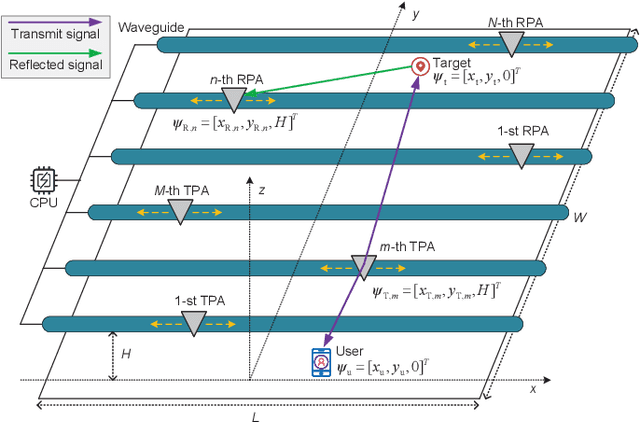
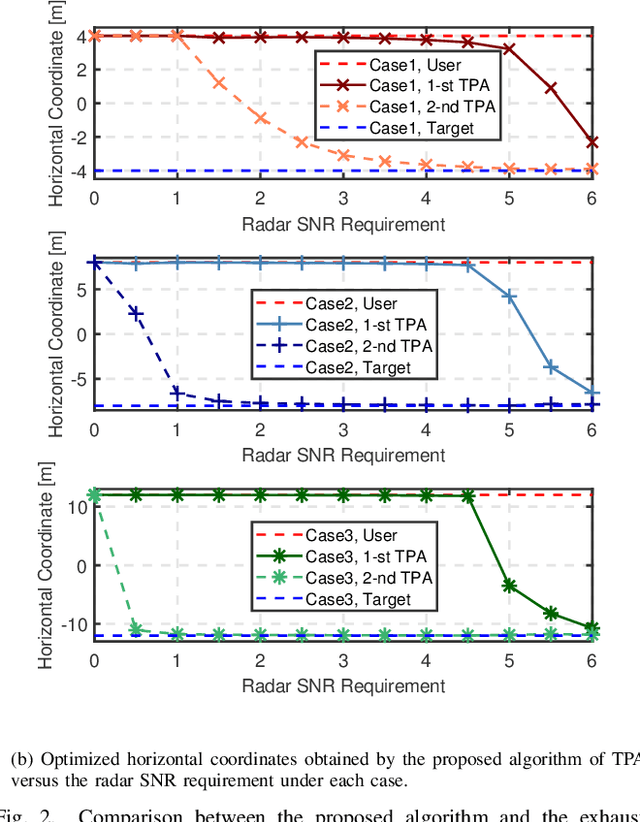
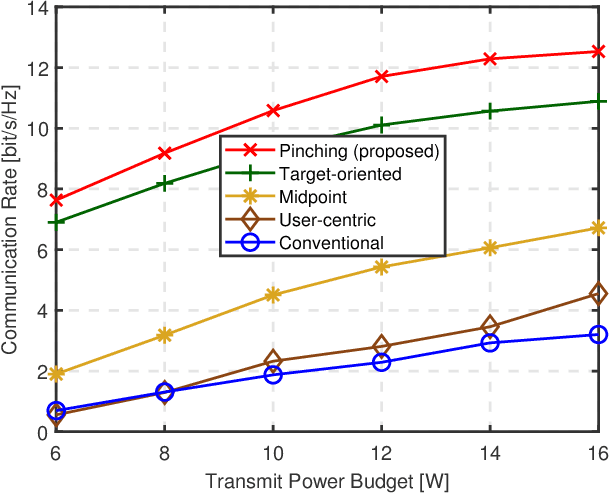
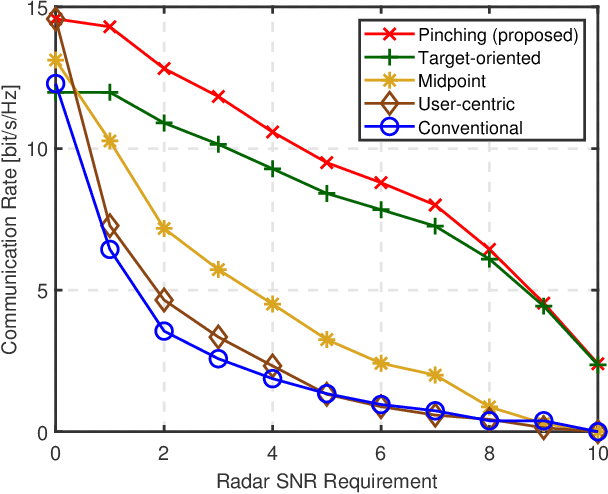
Abstract:Recently, a novel flexible-antenna technology, called pinching antennas, has attracted growing academic interest. By inserting discrete dielectric materials, pinching antennas can be activated at arbitrary points along waveguides, allowing for flexible customization of large-scale path loss. This paper investigates a multi-waveguide pinching-antenna integrated sensing and communications (ISAC) system, where transmit pinching antennas (TPAs) and receive pinching antennas (RPAs) coordinate to simultaneously detect one potential target and serve one downlink user. We formulate a communication rate maximization problem subject to radar signal-to-noise ratio (SNR) requirement, transmit power budget, and the allowable movement region of the TPAs, by jointly optimizing TPA locations and transmit beamforming design. To address the non-convexity of the problem, we propose a novel fine-tuning approximation method to reformulate it into a tractable form, followed by a successive convex approximation (SCA)-based algorithm to obtain the solution efficiently. Extensive simulations validate both the system design and the proposed algorithm. Results show that the proposed method achieves near-optimal performance compared with the computational-intensive exhaustive search-based benchmark, and pinching-antenna ISAC systems exhibit a distinct communication-sensing trade-off compared with conventional systems.
From Large AI Models to Agentic AI: A Tutorial on Future Intelligent Communications
May 28, 2025Abstract:With the advent of 6G communications, intelligent communication systems face multiple challenges, including constrained perception and response capabilities, limited scalability, and low adaptability in dynamic environments. This tutorial provides a systematic introduction to the principles, design, and applications of Large Artificial Intelligence Models (LAMs) and Agentic AI technologies in intelligent communication systems, aiming to offer researchers a comprehensive overview of cutting-edge technologies and practical guidance. First, we outline the background of 6G communications, review the technological evolution from LAMs to Agentic AI, and clarify the tutorial's motivation and main contributions. Subsequently, we present a comprehensive review of the key components required for constructing LAMs. We further categorize LAMs and analyze their applicability, covering Large Language Models (LLMs), Large Vision Models (LVMs), Large Multimodal Models (LMMs), Large Reasoning Models (LRMs), and lightweight LAMs. Next, we propose a LAM-centric design paradigm tailored for communications, encompassing dataset construction and both internal and external learning approaches. Building upon this, we develop an LAM-based Agentic AI system for intelligent communications, clarifying its core components such as planners, knowledge bases, tools, and memory modules, as well as its interaction mechanisms. We also introduce a multi-agent framework with data retrieval, collaborative planning, and reflective evaluation for 6G. Subsequently, we provide a detailed overview of the applications of LAMs and Agentic AI in communication scenarios. Finally, we summarize the research challenges and future directions in current studies, aiming to support the development of efficient, secure, and sustainable next-generation intelligent communication systems.
Energy-Efficient Resource Allocation for NOMA-Assisted Uplink Pinching-Antenna Systems
May 12, 2025Abstract:The pinching-antenna architecture has emerged as a promising solution for reconfiguring wireless propagation environments and enhancing system performance. While prior research has primarily focused on sum-rate maximization or transmit power minimization of pinching-antenna systems, the critical aspect of energy efficiency (EE) has received limited attention. Given the increasing importance of EE in future wireless communication networks, this work investigates EE optimization in a non-orthogonal multiple access (NOMA)-assisted multi-user pinching-antenna uplink system. The problem entails the joint optimization of the users' transmit power and the pinching-antenna position. The resulting optimization problem is non-convex due to tightly coupled variables. To tackle this, we employ an alternating optimization framework to decompose the original problem into two subproblems: one focusing on power allocation and the other on antenna positioning. A low-complexity optimal solution is derived for the power allocation subproblem, while the pinching-antenna positioning subproblem is addressed using a particle swarm optimization algorithm to obtain a high-quality near-optimal solution. Simulation results demonstrate that the proposed scheme significantly outperforms both conventional-antenna configurations and orthogonal multiple access-based pinching-antenna systems in terms of EE.
Sum Rate Maximization for NOMA-Assisted Uplink Pinching-Antenna Systems
May 01, 2025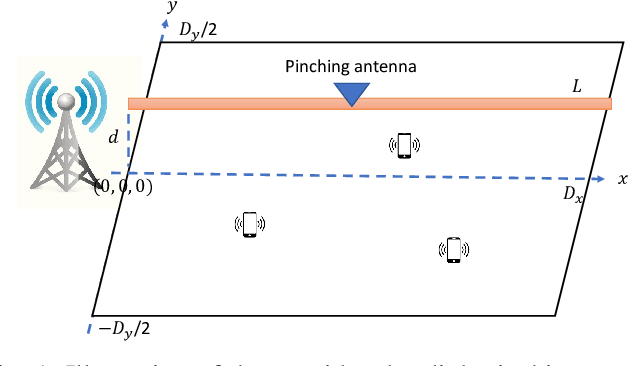
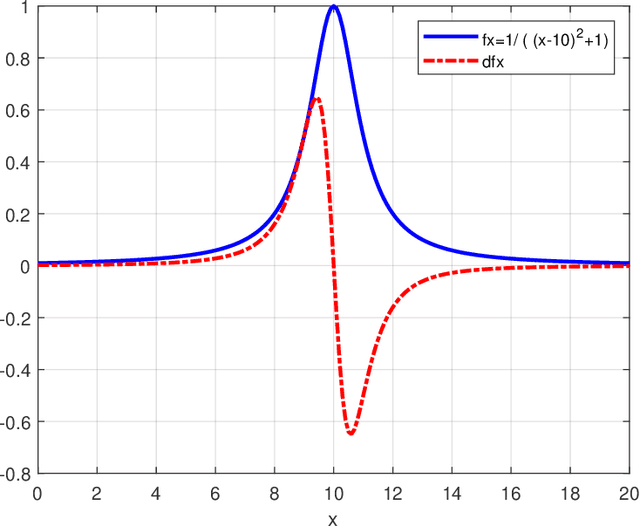
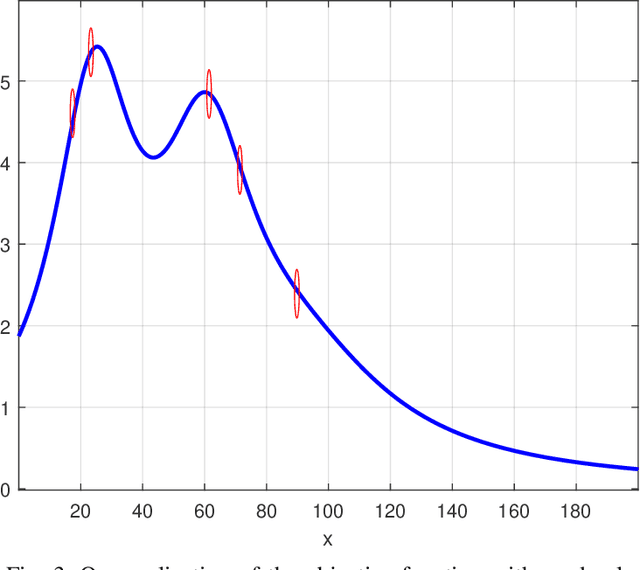
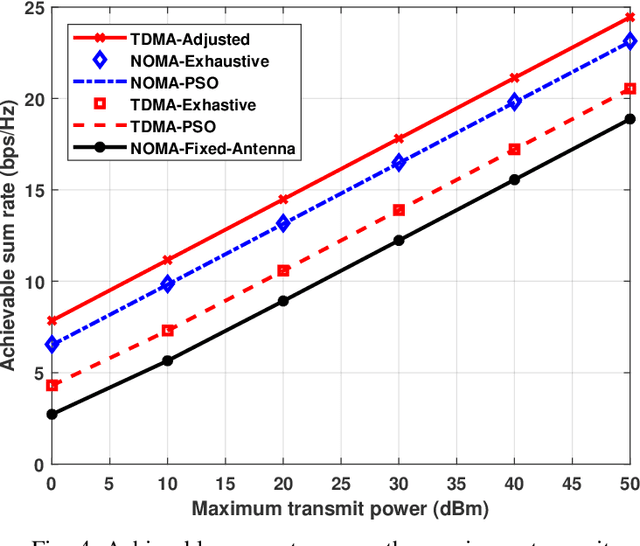
Abstract:In this paper, we investigate an uplink communication scenario in which multiple users communicate with an access point (AP) employing non-orthogonal multiple access (NOMA). A pinching antenna, which can be activated at an arbitrary point along a dielectric waveguide, is deployed at the AP to dynamically reconfigure user channels. The objective is to maximize the system sum rate by jointly optimizing the pinching-antenna's position and the users' transmit powers. The formulated optimization problem is non-convex, and addressed using the particle swarm optimization (PSO) algorithm. For performance benchmarking, two time division multiple access (TDMA) schemes are considered: one based on the pinching antenna individually activated for each user, and the other based on the single-pinching-antenna configuration serving all users. Numerical results demonstrate that the use of the pinching antenna significantly enhances the system sum rate compared to conventional antenna architectures. Moreover, the NOMA-based scheme outperforms the TDMA-based scheme with a single pinching antenna but is outperformed by the TDMA-based approach when the pinching antenna is adaptively configured for each user. Finally, the proposed PSO-based method is shown to achieve near-optimal performance for both NOMA and TDMA with a common pinching-antenna configuration.
Underwater Multi-Wavelength Optical Links With Blue Targets and Constraints: Opportunities and Challenges
Apr 21, 2025Abstract:Underwater optical wireless technologies offer multiple advantages over the acoustic technology. Acoustic signals, for instance, are susceptible to noise from marine sources due to marine life and human activities. This is not the case with optical signals. However, absorption and scattering significantly attenuate optical signals. This limits the communication range and requires higher transmission power or more sensitive receivers to detect transmitted light. Therefore, it is necessary to design underwater optical systems with a higher transmission rate and reduced attenuation. To this end, we introduce a framework for designing optical signaling constellations employing multi-wavelength light sources to account for the transmission distance and achievable rate. In particular, we redefine the color-shift keying (CSK) constraint region to target blue light and adapt to marine environments. We discuss an example of 4-point underwater CSK. The corresponding analytical results demonstrate the trade-offs between the symbol error probability, achievable rate, and transmission range of the proposed scheme.
Survey on Beyond Diagonal RIS Enabled 6G Wireless Networks: Fundamentals, Recent Advances, and Challenges
Mar 11, 2025Abstract:Beyond Diagonal Reconfigurable Intelligent Surfaces (BD-RIS) represent a groundbreaking innovation in sixth-generation (6G) wireless networks, enabling unprecedented control over wireless propagation environments compared to conventional diagonal RIS (D-RIS). This survey provides a comprehensive analysis of BD-RIS, detailing its architectures, operational principles, and mathematical modeling while highlighting its performance benefits. BD-RIS classifications, including single-connected, fully-connected, and group-connected architectures, and their reflective, transmissive, hybrid, and multi-sector operating modes are examined. Recent advances in BD-RIS-enabled 6G networks are reviewed, focusing on critical areas such as channel estimation, sum-rate and spectral efficiency optimization, energy efficiency enhancement, and security. The survey identifies fundamental challenges in BD-RIS research, including hardware design limitations, adaptive channel estimation, and the impact of non-ideal hardware effects. Future research directions for BD-RIS are proposed, emphasizing the integration of artificial intelligence and machine learning (AI/ML), joint optimization of communication and sensing, and enhanced physical layer security (PLS). This study concludes by underscoring BD-RIS's transformative potential to redefine 6G wireless networks, offering valuable insights and lessons for future research and development.
ICGNN: Graph Neural Network Enabled Scalable Beamforming for MISO Interference Channels
Feb 06, 2025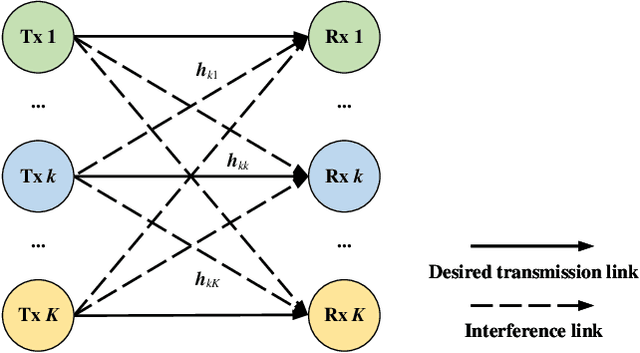
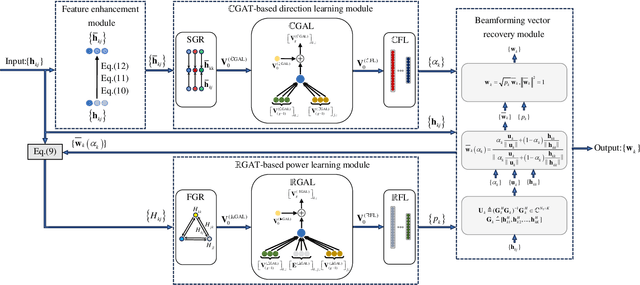
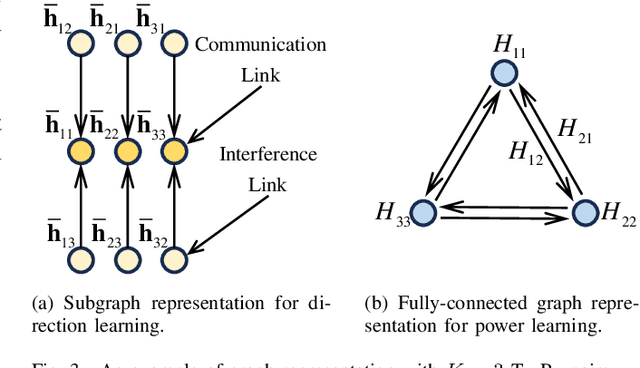

Abstract:This paper investigates the graph neural network (GNN)-enabled beamforming design for interference channels. We propose a model termed interference channel GNN (ICGNN) to solve a quality-of-service constrained energy efficiency maximization problem. The ICGNN is two-stage, where the direction and power parts of beamforming vectors are learned separately but trained jointly via unsupervised learning. By formulating the dimensionality of features independent of the transceiver pairs, the ICGNN is scalable with the number of transceiver pairs. Besides, to improve the performance of the ICGNN, the hybrid maximum ratio transmission and zero-forcing scheme reduces the output ports, the feature enhancement module unifies the two types of links into one type, the subgraph representation enhances the message passing efficiency, and the multi-head attention and residual connection facilitate the feature extracting. Furthermore, we present the over-the-air distributed implementation of the ICGNN. Ablation studies validate the effectiveness of key components in the ICGNN. Numerical results also demonstrate the capability of ICGNN in achieving near-optimal performance with an average inference time less than 0.1 ms. The scalability of ICGNN for unseen problem sizes is evaluated and enhanced by transfer learning with limited fine-tuning cost. The results of the centralized and distributed implementations of ICGNN are illustrated.
 Add to Chrome
Add to Chrome Add to Firefox
Add to Firefox Add to Edge
Add to Edge